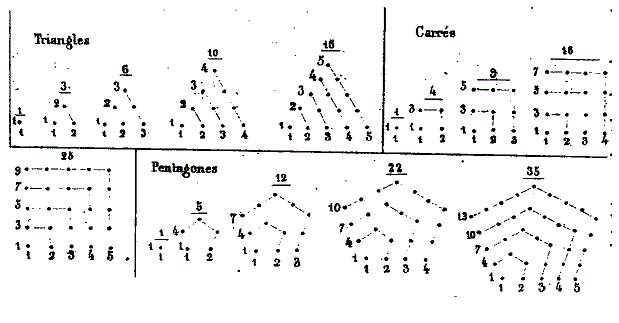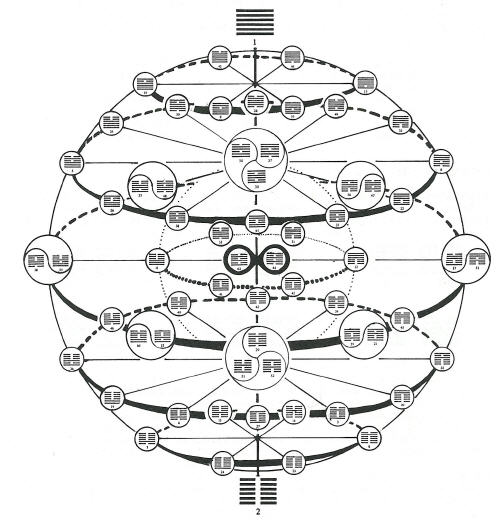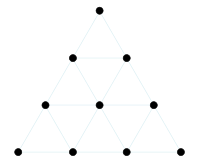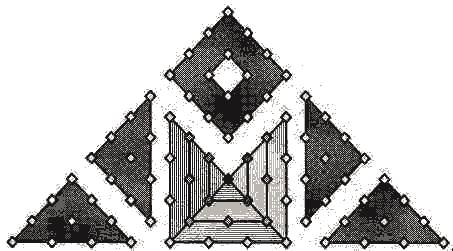Upon reflection, I need to modify something I wrote two posts back:
I want to emphasize that this type of allegory, correspondences between suits and elements, temperaments, seasons, or humors, is not Pythagorean. The correspondences among elements, temperaments, seasons, humors, and qualities were done by Aristotle and his followers.
Actually, it seems to me, this method of looking for hidden relationships among groups of naturally occurring phenomena is Pythagorean-influenced, even if not actually Pythagorean. It started with the reported observations of how the differences in sounds produced by shortening strings or decreasing weights (of blacksmiths' hammers) followed laws that could be used for prediction, namely, the same or similar ratios between string lengths and between weights. The idea is that mathematical rules guided the phenomena we observe in the universe. Plato's, or perhaps Timaeus"s (a real person, a Pythagorean), idea that the universe is built out of unseen triangles and squares is similar, although not directly confirmable by observation. The problem is that analogies were used to fill in the blanks between mathematics and observations, a problem that got worse with Aristotle. Pythagorean thinking didn't get back on track until the Renaissance, first with architects and painters, and then applied to the empirical world with Galileo and Kepler.
Now for a change in subject. While a humorial analysis of the suits that works for the Sola-Busca courts seems to work, approximately, does not work for the number cards, there is a clearly Pythagorean approach that I think does work for those cards. That is one between the Pythagorean account of the first 10 numbers and the corresponding number cards, both in the Sola-Busca illustrations and in the system proposed by Etteilla. I also think it works for the courts, with Pages = 1, Knights = 2, Queens = 3 and Kings = 4. I also think it works for the Marseille order of triumphs from I to X. I have presented my argument on the same thread as Marco's post about the temperaments. It is fairly involved, since it involves 66 cards, 56 of them in two systems. I used mainly the
Theolgumena Arithmeticae, which wasn't readily available outside of Venice and Florence, and then only to the nobility and probably established scholars, in the 15th and early 16th century, until the print edition in 1543 Paris. But similar things were in other works readily available in Latin, as Decker showed in his book
The Esoteric Tarot..In fact his sources in some cases fit better than the
Theologumena.
This is not to advocate (unlike Decker) that the Marseille tarot, or any set of tarot trumps, was built on Pythagorean principles. However it is fairly clear that Etteilla intended his to be such, which is why he insisted it be called "cartonomancy": divination based on numbers with cards. It is an interpretive schema, not an explanation for how the tarot was designed (Etteilla and Decker to the contrary), and Pythagoreanism is quite flexible in its application. But as an explanation, such a scheme might have had some influence on the particular order of triumphs that we see consistently in France.
For clarification, it might help if I explained how my hypothesis differs from that in an account, or perhaps parody, presented as particularly objectionable by Franco Pratesi in a recent note (
http://www.naibi.net/A/518-TRIONF1450-Z.pdf):
Quello che non riesco proprio ad accettare è l’idea che l’ipotetico geniale ideatore, una volta composto il suo sistema esoterico, e selezionate le immagini corrispondenti, non abbia trovato niente di meglio che inserirle e camuffarle in un mazzo di quelle carte da gioco, che si trovavano già da due o tre generazioni nelle mani dei giocatori. In qualche arcano modo, quell’inventore dovrebbe aver convinto fabbricanti e giocatori ad aggiungere al loro mazzo le sue carte speciali; poi il significato nascosto sarebbe stato finalmente decifrato da qualche illuminato visionario solo a partire dalla fine del Settecento, per la soddisfazione di tanti appassionati che ancora oggi coltivano il settore.
Osservo anche che le interpretazioni di tipo esoterico più volte e variamente suggerite dagli “esperti” sarebbero state abbastanza compatibili con l’atmosfera culturale che si creò attorno a Pico della Mirandola, ma si tratta di un’epoca posteriore di almeno mezzo secolo rispetto a quella di interesse e quindi potrebbe solo spiegare qualche eventuale trasformazione di una sequenza di carte trionfali già esistente; prima del 1440 su tutte quelle pseudoscienze – occulte o meno che fossero – non esistevano, o non erano state riscoperte, abbastanza fonti.
(What I just cannot accept is the idea that the supposed genius inventor, once he composed his esoteric system, and selected their corresponding images, would not have found anything better than to place them and camouflage them in a pack of those playing cards, which were already in the hands of players for two or three generations. In some mysterious way, that inventor would have convinced manufacturers and players to add his special cards to their decks; then the hidden meaning would finally be deciphered by some enlightened visionary only in the late eighteenth century, to the satisfaction of many enthusiasts who still cultivate the field.
I note also that the often esoteric interpretations variously suggested by the "experts" would be quite compatible with the cultural atmosphere that was created around Pico della Mirandola, but that is at least half a century later than of interest and then could only explain some eventual transformation of a sequence of triumphal cards already existing; before 1440 on all those pseudosciences - occult or less they were - did not did not exist, or had not been rediscovered, enough sources).
My hypothesis for the correspondence between Etteilla's system for the number cards and that I find illustrated in the Sola-Busca is not that he rediscovered something hidden in the cards. I doubt very much if Etteilla even knew about the Sola-Busca, and it certainly can't be found in the imagery of any other deck, for the number cards. My only guess is that Etteilla used an existing system of cartomancy with the ordinary deck and recognized that it was based on numbers. He did not seem to extend that recognition to the tarot sequence, because he completely changed the order. That pre-existing system may well have had very old roots, extending back even to late 15th century Northern Italy. It could also have been developed later, as Pythagoreanism did not die with the 15th century. The system that Pratesi found in Bologna has some similarities with that of Etteilla, not close but enough to suggest common roots.
Added later: Exactly when it was recognized that Pythagoreanism applied to the Marseille order of triumphs is not clear. The problem is that the Kabbalah also uses a Pythagorean-based approach, which was applied to the tarot first, I think, by Levi. At some point, however, the esotericists realized the Pythagorean basis, because it is rather evident in the work of Zane, who draws links between trumps and number cards.
I very much like the idea of picking Pico della Mirandola as a source of esoteric interpretations, even cartomantic interpretations, for both the ordinary deck and the tarot sequence. He and Poliziano, the expert on Roman history, did go on a tour of Italian libraries, which would have included a stop in Venice, in the decade before the Sola-Busca (with its triumphs based on obscure Roman heroes) was produced, a deck that has all the earmarks of a limited edition for an erudite patron.
That Pico is a half century later than the invention of the tarot is of no relevance to the development of an interpretive schema. Pico was a syncretist, a term that in our day is meant abusively as someone who forces connections among systems where none exist. Most of his interpretive schemas applied to writings much further back than a half century, more like 200-2000 years. No doubt their authors would have been as bewildered as the rest of us by what Pico did with them. I expect that the designers of the tarot, in at least some of its stages, would have felt the same way, if Pico applied his gifts to their products..
However we must remember that Plato's works, much influenced by the Pythagoreans, were the big news in Florence, Milan, and elsewhere even before the tarot, at the dawn of the 15th century. The Visconti had managed to grab Petrarch's own copy of Plato's collected works (this is my deduction from the fact that the Visconti got all of Petrarch's library except Petrarch's own works) and saw the first translation of the
Republic in 1404, done without help from Florence (Hankins,
Plato in the Italian Renaissance, vol. 1 p. 108, in Google Books). There may have been a propaganda motive: Plato's ideal resembled the Visconti state more than that of the Florentine. Florence rose to the challenge, chiefly in the person of the future chancellor, Leonardo Bruni, whose first translation, of the
Phaedo, was in 1405 (Hankins p. 40), achieving a goal much desired by his mentor Salutati (p. 41); other dialogues followed, still in the first decade of the century (p. 51). In 1426-1427, he published a collection of some shorter dialogues and letters, dedicated to Cosimo de' Medici, which circulated widely (Hankins p. 66, not in Google Books). They included most notably part of the Phaedrus, with its famous charioteer. Ambrogio Traversari, architect of the Conclave thought that Platonism should be read through the filter of Christianity, as in pseudo-Dionysius, whom he translated in the late 1430s, a thinker who also can be made to fit the early tarot, if we assume that it had only 16 or so subjects at the time (those of the Cary-Yale, perhaps with some changes in subjects; see my "Platonism and the Tarot", at
http://platonismandtarot.blogspot.com/). And who is to say that the early sponsors, or at least legislators on their use, were not part of the new trend started by Salutati or perhaps earlier? Pico and others might not have had that much to do.









